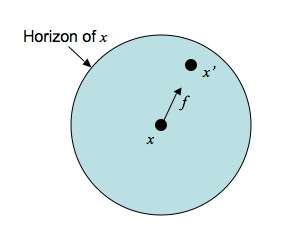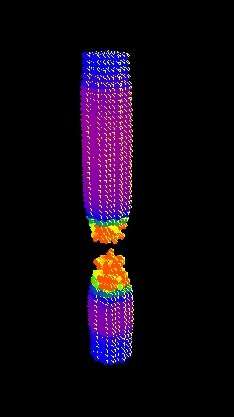Peridynamics

Peridynamics is a formulation of continuum mechanics that is oriented toward deformations with discontinuities, especially fractures.
Purpose of peridynamics
The peridynamic theory is based on integral equations, in contrast with the classical theory of continuum mechanics, which is based on partial differential equations. Since partial derivatives do not exist on crack surfaces and other singularities, the classical equations of continuum mechanics cannot be applied directly when such features are present in a deformation. The integral equations of the peridynamic theory can be applied directly, because they do not require partial derivatives.
The ability to apply the same equations directly at all points in a mathematical model of a deforming structure helps the peridynamic approach avoid the need for the special techniques of fracture mechanics. For example, in peridynamics, there is no need for a separate crack growth law based on a stress intensity factor.
Definition and basic terminology
The basic equation of peridynamics is the following equation of motion:
where is a point in a body , is time, is the displacement vector field, and is the mass density in the undeformed body. is a dummy variable of integration.
The vector valued function is the force density that exerts on . This force density depends on the relative displacement and relative position vectors between and . The dimensions of are force per volume squared. The function is called the "pairwise force function" and contains all the constitutive (material-dependent) properties. It describes how the internal forces depend on the deformation.
The interaction between any and is called a "bond." The physical mechanism in this interaction need not be specified. It is usually assumed that vanishes whenever is outside a neighborhood of (in the undeformed configuration) called the horizon.

The term "peridynamic," an adjective, was proposed in the year 2000 and comes from the prefix peri, which means all around, near, or surrounding; and the root dyna, which means force or power. The term "peridynamics," a noun, is a shortened form of the phrase peridynamic model of solid mechanics.
Pairwise force functions
Using the abbreviated notation and Newton's third law places the following restriction on :
for any . This equation states that the force density vector that exerts on equals minus the force density vector that exerts on . Balance of angular momentum requires that be parallel to the vector connecting the deformed position of to the deformed position of :
A pairwise force function is specified by a graph of versus bond elongation , defined by
A schematic of a pairwise force function for the bond connecting two typical points is shown in the following figure:

Damage
Damage is incorporated in the pairwise force function by allowing bonds to break when their elongation exceeds some prescribed value. After a bond breaks, it no longer sustains any force, and the endpoints are effectively disconnected from each other. When a bond breaks, the force it was carrying is redistributed to other bonds that have not yet broken. This increased load makes it more likely that these other bonds will break. The process of bond breakage and load redistribution, leading to further breakage, is how cracks grow in the peridynamic model.
Peridynamic states

The theory described above assumes that each peridynamic bond responds independently of all the others. This is an oversimplification for most materials and leads to restrictions on the types of materials that can be modeled. In particular, this assumption implies that any isotropic linear elastic solid is restricted to a Poisson ratio of 1/4.
To address this lack of generality, the idea of "peridynamic states" was introduced. This allows the force density in each bond to depend on the stretches in all the bonds connected to its endpoints, in addition to its own stretch. For example, the force in a bond could depend on the net volume changes at the endpoints. The effect of this volume change, relative to the effect of the bond stretch, determines the Poisson ratio. With peridynamic states, any material that can be modeled within the standard theory of continuum mechanics can be modeled as a peridynamic material, while retaining the advantages of the peridynamic theory for fracture.
One can find extended discussion of the integral form of equations of solid body mechanics and restrictions on the form of kernel in I.A.Kunin “Theory of elastic media with microstructure. Nonlocal theory of elasticity. 1975 (In Russian); I. A. Kunin, Elastic Media with Microstructure I. One-Dimensional Models (Springer, Berlin, 1982); I. A. Kunin, Elastic Media with Microstructure II. Three-Dimensional Models (Springer, Berlin, 1983)(In English).
See also
Further reading
- Silling, S. A. (2000). "Reformulation of Elasticity Theory for Discontinuities and Long-Range Forces". Journal of the Mechanics and Physics of Solids. 48: 175–209. doi:10.1016/S0022-5096(99)00029-0.
- S. A. Silling, M. Zimmermann, and R. Abeyaratne, "Deformation of a Peridynamic Bar," Journal of Elasticity, Vol. 73 (2003) 173-190. doi:10.1023/B:ELAS.0000029931.03844.4f
- S. A. Silling and F. Bobaru, "Peridynamic Modeling of Membranes and Fibers," International Journal of Non-Linear Mechanics, Vol. 40 (2005) 395-409. doi:10.1016/j.ijnonlinmec.2004.08.004
- O. Weckner and R. Abeyaratne, "The Effect of Long-Range Forces on the Dynamics of a Bar," Journal of the Mechanics and Physics of Solids, Vol. 53 (2005) 705-728. doi:10.1016/j.jmps.2004.08.006
- S. A. Silling and E. Askari, "A Meshfree Method Based on the Peridynamic Model of Solid Mechanics," Computers and Structures, Vol. 83 (2005) 1526-1535. doi:10.1016/j.compstruc.2004.11.026
- K. Dayal and K. Bhattacharya, "Kinetics of Phase Transformations in the Peridynamic Formulation of Continuum Mechanics," Journal of the Mechanics and Physics of Solids, Vol. 54 (2006) 1811-1842. doi:10.1016/j.jmps.2006.04.001
- W. Gerstle, N. Sau, and S. Silling, "Peridynamic Modeling of Concrete Structures," Nuclear Engineering and Design, Vol. 237 (2007) 1250-1258. doi:10.1016/j.nucengdes.2006.10.002
- W. Gerstle, "Introduction to Practical Peridynamics", World Scientific, Inc., (2016) http://www.worldscientific.com/worldscibooks/10.1142/9687 .
- E. Emmrich and O. Weckner, "On the well-posedness of the linear peridynamic model and its convergence towards the Navier equation of linear elasticity," Communications in Mathematical Sciences, Vol. 5 (2007), pp. 851–864. http://www.intlpress.com/CMS/p/2007/issue5-4/CMS-5-4-A6-Emmrich.pdf
- S. A. Silling, M. Epton, O. Weckner, J. Xu and E. Askari, "Peridynamic States and Constitutive Modeling," Journal of Elasticity, Vol. 88 (2007) 151-184. doi:10.1007/s10659-007-9125-1
- F. Bobaru, "Influence of van der Waals forces on increasing the strength and toughness in dynamic fracture of nanofibre networks: a peridynamic approach," Modelling and Simulation in Materials Science and Engineering, Vol. 15 (2007) 397-417. doi:10.1088/0965-0393/15/5/002
- R. W. Macek and S. A. Silling, "Peridynamics via finite element analysis," Finite Elements in Analysis and Design, Vol. 43, Issue 15, (2007) 1169-1178. doi:10.1016/j.finel.2007.08.012
- S. A. Silling and R. B. Lehoucq, "Convergence of Peridynamics to Classical Elasticity Theory," Journal of Elasticity, Vol. 93 (2008) 13-37. doi:10.1007/s10659-008-9163-3
- M. L. Parks, R. B. Lehoucq, S. Plimpton, and S. Silling, "Implementing peridynamics within a molecular dynamics code," Computer Physics Communications, Vol. 179 (2008), pp. 777–783. doi:10.1016/j.cpc.2008.06.011
- F. Bobaru, M. Yang, L. F. Alves, S. A. Silling, E. Askari, and J. Xu, "Convergence, adaptive refinement, and scaling in 1D peridynamics," International Journal for Numerical Methods in Engineering, Vol. 77, Issue 6 (2009) 852-877. doi:10.1002/nme.2439
- E. Askari, F. Bobaru, R. B. Lehoucq, M. L. Parks, S. A. Silling, and O. Weckner, "Peridynamics for multiscale materials modeling," Scidac 2008. Journal of Physics: Conference Series, Vol. 125 (2008) 012078 (11pp). doi:10.1088/1742-6596/125/1/012078
- P. Seleson, M.L. Parks, M. Gunzburger, and R. B. Lehoucq, "Peridynamics as an upscaling of molecular dynamics," Multiscale Modeling & Simulation, Vol. 8, Issue 1 (2009) 204-227. doi:10.1137/09074807X
- S. A. Silling, O. Weckner, E. Askari, and F. Bobaru, "Crack nucleation in a peridynamic solid," International Journal of Fracture, Vol. 162(1-2), (2010) 219-227. doi:10.1007/s10704-010-9447-z
- YD. Ha and F. Bobaru, "Studies of dynamic crack propagation and crack branching with peridynamics," International Journal of Fracture, Vol. 162(1-2), (2010) 229-244. doi:10.1007/s10704-010-9442-4
- F. Bobaru and M. Duangpanya, "The peridynamic formulation for transient heat conduction," International Journal of Heat and Mass Transfer, Vol. 53(19-20), (2010) 4047-4059. doi:10.1016/j.ijheatmasstransfer.2010.05.024
- S.A. Silling and R.B. Lehoucq,"Peridynamic Theory of Solid Mechanics," Advances in Applied Mechanics, Vol. 44, (2010) 73-168. doi:10.1016/S0065-2156(10)44002-8
- YD. Ha and F. Bobaru, "Characteristics of dynamic brittle fracture captured with peridynamics," Engineering Fracture Mechanics, Vol. 78, (2011) 1156–1168. doi:10.1016/j.engfracmech.2010.11.020
- A. Agwai, I. Guven, and E. Madenci, "Predicting crack propagation with peridynamics: a comparative study," International Journal of Fracture, Vol. 171(1), (2011) 65-78. doi:10.1007/s10704-011-9628-4
- S.A. Silling, "Coarsening method for linear peridynamics," International Journal for Multiscale Computational Engineering, Vol. 9(6), (2011) 609-622. doi:10.1615/IntJMultCompEng.2011002674
- O. Weckner and S.A. Silling, "Determination of nonlocal constitutive equations from phonon dispersion relations," International Journal for Multiscale Computational Engineering, Vol. 9(6), (2011) 623-634. doi:10.1615/IntJMultCompEng.2011002688
- F. Bobaru and YD. Ha, "Adaptive refinement and multiscale modeling in 2D peridynamics," International Journal for Multiscale Computational Engineering, Vol. 9(6), (2011) 635-660. doi:10.1615/IntJMultCompEng.2011002793
- N. Burch and R. Lehoucq, "Classical, nonlocal, and fractional diffusion equations in bounded domains," International Journal for Multiscale Computational Engineering, Vol. 9(6), (2011) 661-674. doi:10.1615/IntJMultCompEng.2011002402
- J. Foster, S.A. Silling, and W. Chen, "An energy based failure criterion for use with peridynamic states," International Journal for Multiscale Computational Engineering, Vol. 9(6), (2011) 675-688. doi:10.1615/IntJMultCompEng.2011002407
- P. Seleson, M. Parks, "On the role of the influence function in the peridynamics theory," International Journal for Multiscale Computational Engineering, Vol. 9(6), (2011) 689-706. doi:10.1615/IntJMultCompEng.2011002527
- W. Hu, YD. Ha, and F. Bobaru, "Modeling dynamic fracture and damage in a fiber-reinforced composite lamina with peridynamics," International Journal for Multiscale Computational Engineering, Vol. 9(6), (2011) 707-726. doi:10.1615/IntJMultCompEng.2011002651
- T. Jia and D. Liu, Peridynamic Applications for Orthotropic Materials, Army Research Office, September, 2012. http://www.dtic.mil/cgi-bin/GetTRDoc?AD=ADA586026
- F. Bobaru and W. Hu, "The meaning, selection, and use of the Peridynamic horizon and its relation to crack branching in brittle materials," International Journal of Fracture, Vol. 176, (2012) 215–222. doi:10.1007/s10704-012-9725-z
- W. Hu, YD. Ha, F. Bobaru, and S.A. Silling, "The formulation and computation of the nonlocal J-integral in bond-based Peridynamics," International Journal of Fracture, Vol. 176, (2012) 195–206. doi:10.1007/s10704-012-9745-8
- W. Hu, YD. Ha, and F. Bobaru, "Peridynamic model for dynamic fracture in unidirectional fiber-reinforced composites," Computer Methods in Applied Mechanics and Engineering, Vol. 217–220, (2012) 247–261. doi:10.1016/j.cma.2012.01.016
- F. Bobaru and M. Duangpanya, "A Peridynamic Formulation for Transient Heat Conduction in Bodies with Evolving Discontinuities," Journal of Computational Physics, Vol. 231(7), (2012) 2764-2785. doi:10.1016/j.jcp.2011.12.017
- S. R. Chowdhury, M. M. Rahaman, D. Roy, and N. Sundaram, "A micropolar peridynamic theory in linear elasticity," International Journal of Solids and Structures, Vol. 59, (2015) 171-182. doi:10.1016/j.ijsolstr.2015.01.018
- R. Lipton, "Cohesive Dynamics and Brittle Fracture," Journal of Elasticity, (2015) 1-49. doi:10.1007/s10659-015-9564-z
- P. Diehl, F. Franzelin, D. Pflüger, and G. C. Ganzenmüller, "Bond-based peridynamics: a quantitative study of Mode I crack opening", International Journal of Fracture, (2016), 1-14. doi:10.1007/s10704-016-0119-5
- E. Madenci and E. Oterkus, "Peridynamic Theory and Its Applications", Springer, (2014) http://link.springer.com/book/10.1007%2F978-1-4614-8465-3.
- D. De Meo, N. Zhu and E. Oterkus, "Peridynamic Modeling of Granular Fracture in Polycrystalline Materials," ASME Journal of Engineering Materials and Technology, Vol. 138 (4), (2016) 041008. doi:10.1115/1.4033634
- S. R. Chowdhury, P. Roy, D. Roy, & J.N. Reddy, "A peridynamic theory for linear elastic shells," International Journal of Solids and Structures, Vol. 84, (2016), 110-132. doi:10.1016/j.ijsolstr.2016.01.019
External links
- Peridigm, an open-source computational peridynamics code
- FNSG, a library for fast neighbor search on GPU
- Peridynamic GUI and geometry generator
- website on peridynamics